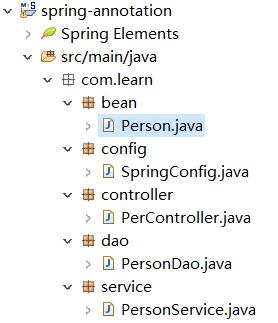一、注解定义
@ComponentScan注解的定义如下:
@Retention(RetentionPolicy.RUNTIME)@Target(ElementType.TYPE)@Documented@Repeatable(ComponentScans.class)public @interface ComponentScan { /** * 扫描路径 * @ComponentScan(value = "spring.annotation.componentscan") */ @AliasFor("basePackages") String[] value() default {}; /** * 扫描路径 */ @AliasFor("value") String[] basePackages() default {}; /** * 指定扫描类 * @ComponentScan(basePackageClasses = {BookDao.class, BookService.class}) */ Class>[] basePackageClasses() default {}; /** * 命名注册的Bean,可以自定义实现命名Bean, * 1、@ComponentScan(value = "spring.annotation.componentscan",nameGenerator = MyBeanNameGenerator.class) * MyBeanNameGenerator.class 需要实现 BeanNameGenerator 接口,所有实现BeanNameGenerator 接口的实现类都会被调用 * 2、使用 AnnotationConfigApplicationContext 的 setBeanNameGenerator方法注入一个BeanNameGenerator * BeanNameGenerator beanNameGenerator = (definition,registry)-> String.valueOf(new Random().nextInt(1000)); * AnnotationConfigApplicationContext annotationConfigApplicationContext = new AnnotationConfigApplicationContext(); * annotationConfigApplicationContext.setBeanNameGenerator(beanNameGenerator); * annotationConfigApplicationContext.register(MainConfig2.class); * annotationConfigApplicationContext.refresh(); * 第一种方式只会重命名@ComponentScan扫描到的注解类 * 第二种只有是初始化的注解类就会被重命名 * 列如第一种方式不会重命名 @Configuration 注解的bean名称,而第二种就会重命名 @Configuration 注解的Bean名称 */ Class extends BeanNameGenerator> nameGenerator() default BeanNameGenerator.class; /** * 用于解析@Scope注解,可通过 AnnotationConfigApplicationContext 的 setScopeMetadataResolver 方法重新设定处理类 * ScopeMetadataResolver scopeMetadataResolver = definition -> new ScopeMetadata(); 这里只是new了一个对象作为演示,没有做实际的逻辑操作 * AnnotationConfigApplicationContext annotationConfigApplicationContext = new AnnotationConfigApplicationContext(); * annotationConfigApplicationContext.setScopeMetadataResolver(scopeMetadataResolver); * annotationConfigApplicationContext.register(MainConfig2.class); * annotationConfigApplicationContext.refresh(); * 也可以通过@ComponentScan 的 scopeResolver 属性设置 *@ComponentScan(value = "spring.annotation.componentscan",scopeResolver = MyAnnotationScopeMetadataResolver.class) */ Class extends ScopeMetadataResolver> scopeResolver() default AnnotationScopeMetadataResolver.class; /** * 用来设置类的代理模式 */ ScopedProxyMode scopedProxy() default ScopedProxyMode.DEFAULT; /** * 扫描路径 如 resourcePattern = "**/*.class" * 使用 includeFilters 和 excludeFilters 会更灵活 */ String resourcePattern() default ClassPathScanningCandidateComponentProvider.DEFAULT_RESOURCE_PATTERN; /** * 指示是否应启用对带有{@code @Component},{@ code @Repository}, * {@ code @Service}或{@code @Controller}注释的类的自动检测。 */ boolean useDefaultFilters() default true; /** * 对被扫描的包或类进行过滤,若符合条件,不论组件上是否有注解,Bean对象都将被创建 * @ComponentScan(value = "spring.annotation.componentscan",includeFilters = { * @ComponentScan.Filter(type = FilterType.ANNOTATION, classes = {Controller.class, Service.class}), * @ComponentScan.Filter(type = FilterType.ASSIGNABLE_TYPE, classes = {SchoolDao.class}), * @ComponentScan.Filter(type = FilterType.CUSTOM, classes = {MyTypeFilter.class}), * @ComponentScan.Filter(type = FilterType.ASPECTJ, pattern = "spring.annotation..*"), * @ComponentScan.Filter(type = FilterType.REGEX, pattern = "^[A-Za-z.]+Dao$") * },useDefaultFilters = false) * useDefaultFilters 必须设为 false */ Filter[] includeFilters() default {}; /** * 指定哪些类型不适合进行组件扫描。 * 用法同 includeFilters 一样 */ Filter[] excludeFilters() default {}; /** * 指定是否应注册扫描的Bean以进行延迟初始化。 * @ComponentScan(value = "spring.annotation.componentscan",lazyInit = true) */ boolean lazyInit() default false; /** * 用于 includeFilters 或 excludeFilters 的类型筛选器 */ @Retention(RetentionPolicy.RUNTIME) @Target({}) @interface Filter { /** * 要使用的过滤器类型,默认为 ANNOTATION 注解类型 * @ComponentScan.Filter(type = FilterType.ANNOTATION, classes = {Controller.class, Service.class}) */ FilterType type() default FilterType.ANNOTATION; /** * 过滤器的参数,参数必须为class数组,单个参数可以不加大括号 * 只能用于 ANNOTATION 、ASSIGNABLE_TYPE 、CUSTOM 这三个类型 * @ComponentScan.Filter(type = FilterType.ANNOTATION, value = {Controller.class, Service.class}) * @ComponentScan.Filter(type = FilterType.ASSIGNABLE_TYPE, classes = {SchoolDao.class}) * @ComponentScan.Filter(type = FilterType.CUSTOM, classes = {MyTypeFilter.class}) */ @AliasFor("classes") Class>[] value() default {}; /** * 作用同上面的 value 相同 * ANNOTATION 参数为注解类,如 Controller.class, Service.class, Repository.class * ASSIGNABLE_TYPE 参数为类,如 SchoolDao.class * CUSTOM 参数为实现 TypeFilter 接口的类 ,如 MyTypeFilter.class * MyTypeFilter 同时还能实现 EnvironmentAware,BeanFactoryAware,BeanClassLoaderAware,ResourceLoaderAware * 这四个接口 * EnvironmentAware * 此方法用来接收 Environment 数据 ,主要为程序的运行环境,Environment 接口继承自 PropertyResolver 接口, * 详细内容在下方 * @Override * public void setEnvironment(Environment environment) { * String property = environment.getProperty("os.name"); * } * * BeanFactoryAware * BeanFactory Bean容器的根接口,用于操作容器,如获取bean的别名、类型、实例、是否单例的数据 * @Override * public void setBeanFactory(BeanFactory beanFactory) throws BeansException { * Object bean = beanFactory.getBean("BeanName") * } * * BeanClassLoaderAware * ClassLoader 是类加载器,在此方法里只能获取资源和设置加载器状态 * @Override * public void setBeanClassLoader(ClassLoader classLoader) { * ClassLoader parent = classLoader.getParent(); * } * * ResourceLoaderAware * ResourceLoader 用于获取类加载器和根据路径获取资源 * public void setResourceLoader(ResourceLoader resourceLoader) { * ClassLoader classLoader = resourceLoader.getClassLoader(); * } */ @AliasFor("value") Class>[] classes() default {}; /** * 这个参数是 classes 或 value 的替代参数,主要用于 ASPECTJ 类型和 REGEX 类型 * ASPECTJ 为 ASPECTJ 表达式 * @ComponentScan.Filter(type = FilterType.ASPECTJ, pattern = "spring.annotation..*") * REGEX 参数为 正则表达式 * @ComponentScan.Filter(type = FilterType.REGEX, pattern = "^[A-Za-z.]+Dao$") */ String[] pattern() default {}; }}二、使用
1.环境准备
创建Maven项目,添加依赖:
org.springframework spring-context 4.3.26.RELEASEjunitjunit4.12test创建bean,controller,dao,service层,并在类上加上对应的注解,项目结构如下:

编写测试类,如下:
public class IoCTest {@Testpublic void test01() {//获取Spring的IOC容器ApplicationContext applicationContext=new AnnotationConfigApplicationContext(SpringConfig.class);//从容器中获取bean String[] names= applicationContext.getBeanDefinitionNames(); for(String i:names) { System.out.println(i); }}}2.excludeFilters的使用
使用excludeFilters不扫描com.learn包中的Controller、Service注解,如下:
@Configuration@ComponentScan(basePackages = "com.learn",excludeFilters = {@Filter(type = FilterType.ANNOTATION,classes = {Controller.class,Service.class})})public class SpringConfig {}上面使用的excludeFilters用于设置排除的过滤条件,实现Filter接口的type属性用于设置过滤类型,默认值为FilterType.ANNOTATION,提供了这几个过滤类型:
- FilterType.ANNOTATION:按照注解过滤
- FilterType.ASSIGNABLE_TYPE:按照给定的类型过滤
- FilterType.ASPECTJ:按照ASPECTJ表达式过滤
- FilterType.REGEX:按照正则表达式过滤
- FilterType.CUSTOM:按照自定义规则过滤
classes和value属性为过滤器的参数,必须为class数组,类只能为以下三种类型:
- ANNOTATION 参数为注解类,如 Controller.class, Service.class,
Repository.class - ASSIGNABLE_TYPE 参数为类,如 SchoolDao.class
- CUSTOM 参数为实现 TypeFilter 接口的类 ,如 MyTypeFilter.class
3.includeFilters的使用
includeFilters属性用于定义扫描过滤条件,满足该条件才进行扫描。用法与excludeFilters一样。
但是因为useDefaultFilters属性默认为true,即使用默认的过滤器,启用对带有@Component,@Repository,@Service,@Controller注释的类的自动检测。会将带有这些注解的类注册为bean装配到IoC容器中。所以使用includeFilters时,需要把useDefaultFilters设置为false,如下:
@Configuration@ComponentScan(basePackages = "com.learn",includeFilters = {@Filter(type = FilterType.ANNOTATION,classes = {Controller.class,Service.class})},useDefaultFilters = false)public class SpringConfig {}结果如下,只扫描了带有Controller,Service注解的自定义的类:

4.自定义过滤规则
@ComponentScan注解扫描或解析的bean只能是Spring内部所定义的,比如@Component、@Service、@Controller或@Repository。如果要扫描一些自定义的注解,就可以自定义过滤规则来完成这个操作。
自定义一个类MyTypeFilter实现TypeFilter接口,这样这个TypeFilter就扫描所有类并只通过类名包含了controller的类,如下:
public class MyTypeFilter implements TypeFilter { /** * 两个参数的含义: * metadataReader:包含读取到的当前正在扫描的类的信息 * metadataReaderFactory:可以获取到当前正在扫描的类的其他类信息(如父类和接口) * match方法返回false即不通过过滤规则,true通过过滤规则 */@Overridepublic boolean match(MetadataReader metadataReader, MetadataReaderFactory metadataReaderFactory)throws IOException {// TODO Auto-generated method stub //获取当前类注解的信息 AnnotationMetadata annotationMetadata = metadataReader.getAnnotationMetadata(); //获取当前正在扫描的类的类信息 ClassMetadata classMetadata = metadataReader.getClassMetadata(); //获取当前类资源(类的路径) Resource resource = metadataReader.getResource(); String className = classMetadata.getClassName(); if(className.contains("controller")){ return true; } return false;}}在@ComponentScan注解中进行配置,如下:
@Configuration@ComponentScan(basePackages = "com.learn",includeFilters = {@Filter(type = FilterType.ASSIGNABLE_TYPE,classes = {Person.class}),@Filter(type = FilterType.CUSTOM,classes = {MyTypeFilter.class}),},useDefaultFilters = false)public class SpringConfig {}经过上面的配置,第一个@Filter通过FilterType.ASSIGNABLE_TYPE规定了只扫描Person类型的类,第二个@Filter通过FilterType.CUSTOM自定义过滤规则规定了只扫描类名包含controller的类。结果:

关注我,私信回复【资料】即可领取视频中java相关资料以及一份227页最新的bat大厂面试宝典
最后
欢迎大家一起交流,喜欢文章记得关注我点个赞哟,感谢支持!







 本文详细介绍了@ComponentScan注解的定义、使用方法,包括环境准备、excludeFilters和includeFilters的配置,以及如何自定义过滤规则。通过实例展示了如何排除和包含特定类型的类,并解释了useDefaultFilters的重要性。最后鼓励读者交流学习,提供相关学习资源。
本文详细介绍了@ComponentScan注解的定义、使用方法,包括环境准备、excludeFilters和includeFilters的配置,以及如何自定义过滤规则。通过实例展示了如何排除和包含特定类型的类,并解释了useDefaultFilters的重要性。最后鼓励读者交流学习,提供相关学习资源。

















 被折叠的 条评论
为什么被折叠?
被折叠的 条评论
为什么被折叠?








